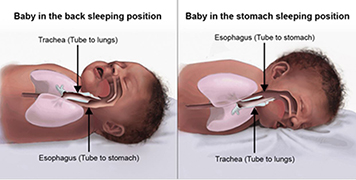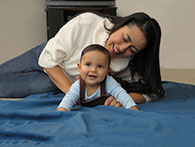Frequently Asked Questions (FAQs) About SIDS and Safe Infant Sleep
Still have questions?
If after reviewing this page you still have questions, we invite you to email us.
More info can be also be found on US Department of Health and Human Services' website.
Thank you for visiting Alameda County Public Health Department’s SIDS Frequently Asked Questions Page. Sudden Infant Death Syndrome (SIDS) can be a very scary topic to think about or discuss. Much has been said and written about SIDS but not all of what you may have heard and/or read about it is true.
This page is designed to give you the facts about SIDS. While the cause of SIDS is still unknown, there are steps you can take to reduce its risk. We also share those steps on this page.
Q. Will my baby choke if placed on his or her back to sleep?

A. No. Healthy babies naturally swallow or cough up fluids—it's a reflex all people have to make sure their airway is kept clear.
Babies might actually clear such fluids better when on their backs because of the location of the windpipe (trachea) when in the back-sleep position.
When the baby is in the back-sleep position, the windpipe lies on top of the esophagus, which leads to the stomach. Anything regurgitated or refluxed from the stomach through the esophagus has to work against gravity to enter the trachea and cause choking. When the baby is sleeping on its stomach, such fluids will exit the esophagus and pool at the opening for the trachea, making choking much more likely.
Cases of fatal choking are very rare except when related to a medical condition. The number of fatal choking deaths has not increased since back sleeping recommendations began. In most of the few reported cases of fatal choking, an infant was sleeping on his or her stomach.
Q. Why should I place my baby on his or her back to sleep?
A. Research shows that the back-sleep position is the safest for babies. The back-sleep position carries the lowest risk of SIDS.
Research also shows that babies who sleep on their backs are less likely to get fevers, stuffy noses, and ear infections. The back-sleep position makes it easier for babies to look around the room and to move their arms and legs.
Remember: Babies sleep safest on their backs, and every sleep time counts!
Q. I was placed to sleep on my stomach as a baby. Was that wrong?
A. We didn't know as much about SIDS or ways to reduce the risk until the early 1990s. Most of us slept on our stomachs—and we survived. But many babies didn't. There is no way to know which babies will die of SIDS, but we do know how to reduce the risk. One of the most effective and easiest ways to reduce the risk of SIDS is to place your baby on his or her back to sleep for naps and at night.
In the early 1990s, when infant stomach sleeping was more common, almost 5,000 babies died of SIDS each year. Today, as more babies sleep on their backs, fewer than half that many babies—about 2,000—die from SIDS every year. These statistics support the recommendation that you should always place your baby on his or her back to sleep.
Q. What if my baby can't get used to sleeping on his or her back?
A. The baby's comfort is important, but safety is more important. Parents and caregivers should place babies on their backs to sleep even if they seem less comfortable or sleep more lightly than when on their stomachs.
Some babies don't like sleeping on their backs at first, but most get used to it quickly. The earlier you start placing your baby on his or her back to sleep, the more quickly your baby will adjust to the position.
Q. Is it okay if my baby sleeps on his or her side?
A. Babies placed to sleep on their sides are at increased risk for SIDS. For this reason, babies should sleep wholly on their backs—the position associated with the lowest SIDS risk.
Q. I saw a product that said it could prevent SIDS and keep my baby in the right position during sleep. Can i use it to prevent SIDS?
A. There is no known way or product to prevent SIDS. The U.S. Food and Drug Administration, the Consumer Product Safety Commission, the American Academy of Pediatrics, and other organizations warn against using these products because of the dangers they pose to babies. You should not use these products for your baby.
Q. What if my baby rolls onto his or her stomach during sleep? Do I need to put my baby in the back-sleep position again if this happens?
A. No. Rolling over is an important and natural part of your baby's growth. Most babies start rolling over on their own around 4 to 6 months of age. If your baby rolls over on his or her own during sleep, you do not need to turn the baby over onto his or her back. The important thing is that your baby starts every sleep time on his or her back to reduce the risk of SIDS, and that there is no soft, loose bedding in the baby's sleep area.
Q. What if my baby's grandparents or another caregiver wants to place my baby to sleep on his or her stomach for naptime?
A. Babies who usually sleep on their backs but who are then placed to sleep on their stomachs, such as for a nap, are at very high risk for SIDS. So, it is important for everyone who cares for your baby to use the back-sleep position for all sleep times—for naps and at night.
Q. Why shouldn't I use crib bumpers in my baby's sleep area?
A. Bumper pads and similar products that attach to crib slats or sides are frequently used with the thought of protecting infants from injury. However, evidence does not support using crib bumpers to prevent injury. In fact, crib bumpers can cause serious injuries or death. Keeping them out of your baby's sleep area is the best way to avoid these dangers.
Before crib safety was regulated, the spacing between the slats of the crib sides could be any width, which posed a danger to infants if they were too wide. Parents and caregivers used padded crib bumpers to protect infants. Now that cribs must meet safety standards, the slats don't pose the same dangers. As a result, the bumpers are no longer needed.
 Q. Are there times when my baby should be on his or her stomach?
Q. Are there times when my baby should be on his or her stomach?
A. Yes, you baby should have plenty of Tummy Time when he or she is awake and when someone is watching. Supervised Tummy Time helps strengthen your baby's neck and shoulder muscles, build motor skills, and helps prevent flat spots on the back of the head.
Q. Will my baby get flat spots on the back of the head from sleeping on his or her back?
A. When it occurs too often or for too long a time, pressure on the same part of the baby's head can cause flat spots. Such flat spots are usually not dangerous and typically go away on their own once the baby starts sitting up. The flat spots also are not linked to long-term problems with head shape. Making sure your baby gets enough Tummy Time is one way to help prevent these flat spots. Check out the other things parents and caregivers can do to prevent flat spots on the back of the head. Visit the Other Ways To Help Prevent Flat Spots on Baby's Head section of this website for more information.
Q. How old are babies who die from SIDS?
A. The majority (90%) of SIDS deaths occur before a baby reaches 6 months of age, and the number of SIDS deaths peaks between 1 month and 4 months of age. However, SIDS deaths can occur anytime during a baby's first year, so parents should still follow safe sleep recommendations to reduce the risk of SIDS until their baby's first birthday.
Q. What are other sleep-related causes of infant death?
A. Other sleep-related causes of infant death are those that occur in the sleep environment or during sleep time. They include accidental suffocation by bedding, entrapment (when a baby gets trapped between two objects, such as a mattress and wall, and can't breathe), or strangulation (when something presses on or wraps around a baby's neck, blocking the baby's airway). These deaths are not SIDS.

